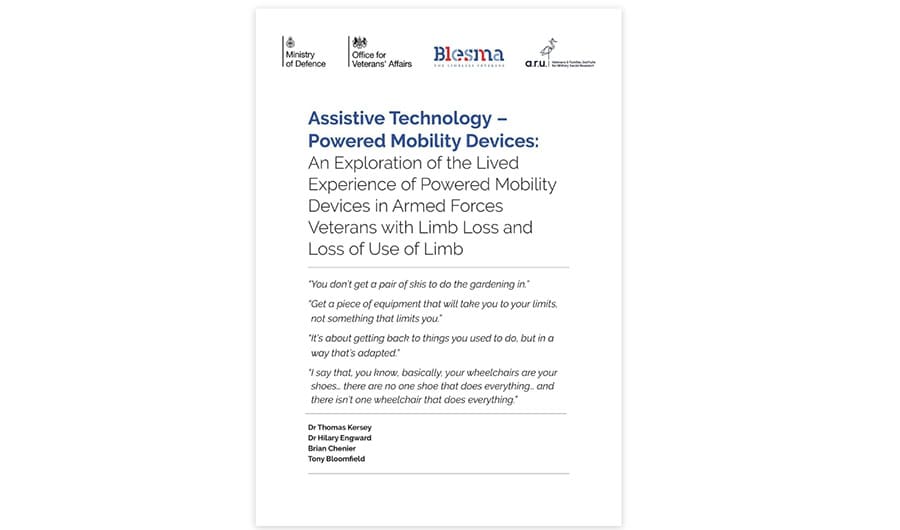A report has gathered evidence from 26 veterans who provided their first-hand experiences of their individual journeys to accessing assistive technologies to help influence future policies from the Office for Veterans’ Affairs (OVA).
Funded by the OVA and delivered by Blesma in association with Anglia Ruskin University, the report identifies a range of measures to improve the accessibility, affordability, and usability of assistive technology (AT), such as wheelchairs, prosthetics, and mobility scooters.
The study, which was powered by the lived experience testimony of Blesma members, highlighted how AT can empower veterans and their families to live independently but also exposed systemic barriers that limit access.
Its recommendations, covering issues from veterans’ acceptance of the need to use ATs to the sales approaches of private companies, will influence future policies from the OVA.
Titled ‘Assistive Technology – Powered Mobility Devices: An Exploration of the Lived Experience of Powered Mobility Devices in Armed Forces Veterans with Limb Loss and Loss of Use of Limb’, the report also establishes a decision-making guide to help veterans select and fund the right equipment for their needs.
The initial and associated maintenance costs of ATs was a common theme among veterans. Many reported that suppliers focused on sales over truly understanding their specific needs.
Dr Thomas Kersey, Research Fellow at Anglia Ruskin University’s Veterans & Families Institute for Military Social Research, who led the project, commented: “There was a strong feeling that the suppliers tend to be sales people first and do not really take into account a veteran’s needs so we have developed a matrix within the report so a veteran can use it to work out what sort of AT would work using an informative tool to help guide their purchase rather than being at the mercy of a sales approach.
“One of the goals of the research is to help people get the equipment and technology that works for them empowering individuals to make informed decisions.”
Blesma members’ honest testimonies of their experiences helped shine a light on fault lines in AT provision and underscore the physical and psychological benefit from accessing the right equipment.
Dr Kersey added: “Their input was vital. You need the human elements of their stories to understand how fundamental this sort of equipment is to their everyday lives.
“One of the members said she was getting a gyroscopic wheelchair that could be used hands-free, which meant she could walk down the street holding her son’s hand. It is such a powerful image and statement.
“A disability really changes the dynamics of family life but the right AT can re-address that balance by allowing people to do things on their own and move from being someone who is being cared for back to family life.”
The report acknowledges that ATs not only give independence to individuals but also have a direct impact on family life by bringing a rebalance to the roles within the family. It meant that AT users could contribute to the daily running of the home and reduce the care demands, allowing family members to step out of the care role.
However, it also found that uptake of ATs was nuanced, and there were several barriers to accepting ATs into everyday life.
Some of the barriers to initial uptake of ATs included people feeling like using equipment meant they had given up, pride and stubbornness in accepting help, and people’s own pre-conceived notions of what it means to be disabled.
Although, on reflection, veterans said they would accept the help if offered it again as it would preserve and maintain their health for longer had they accepted assistive technology into their lives sooner.
The report’s recommendations include tailoring AT provision on an individual level considering the long-term impact on wellbeing and independence, establishing an ethical code of conduct for the AT industry, expanding funding and financial support for ATs, improving transportation and storage solutions, and recycling and reuse opportunities.
Brian Chenier, Blesma Support Officer Prosthetics, said: “This report is going to be useful to so many people, not just those that need ATs, but those that provide them
“Funding for statutory provision is limited and getting the best outcomes with such limited funding just makes sense. We hope that NHS providers will embrace the opportunity to look beyond the basic provision and consider the benefits ATs can have.
“By shining a light on the benefits of ATs covered in this report, we would expect users to be more confident in the decisions they make, and that they are able to make those decisions much earlier. It will also be useful to charities like Blesma that are often asked to fund ATs that are not available through statutory funding/services. Helping us to understand the wider, more holistic positive impact our support can have is very important.
“We are grateful to the OVA for funding this research and to our members that took part. This will make a positive impact, and we aim to share this report across statutory services and the charity sector.”
The OVA added: “Our veterans have shown extraordinary courage and made immense sacrifices in service to our country. We owe them our ongoing support long after they have hung up their uniform.
“The 22 projects funded through the £5 million Veterans’ Health Innovation Fund are helping to transform healthcare for those who have served the UK. Blesma’s research into assistive technologies is an excellent example of why this work matters so much. Its research will help veterans and their carers to understand the most effective mobility aids for their specific needs, helping them regain independence.
“This is why we’re investing in these projects – because our commitment to veterans doesn’t end when they leave the Armed Forces.”
The post Veterans requiring assistive tech stated that suppliers focus on sales over understanding their specific needs appeared first on AT Today – Assistive Technology.

